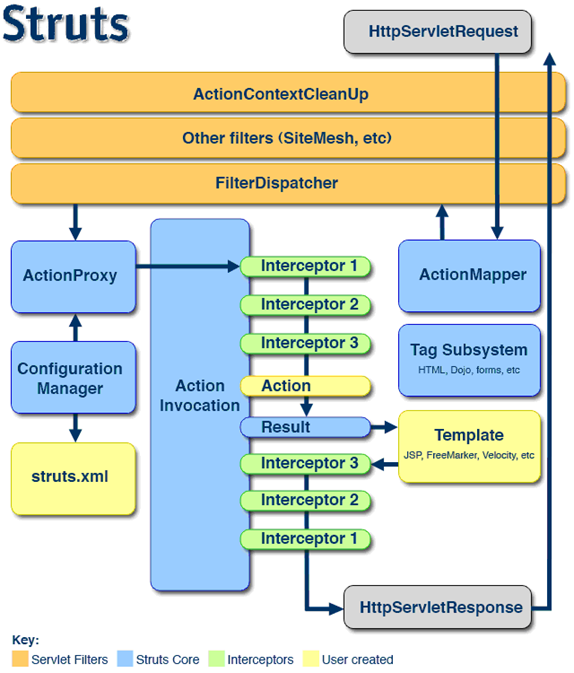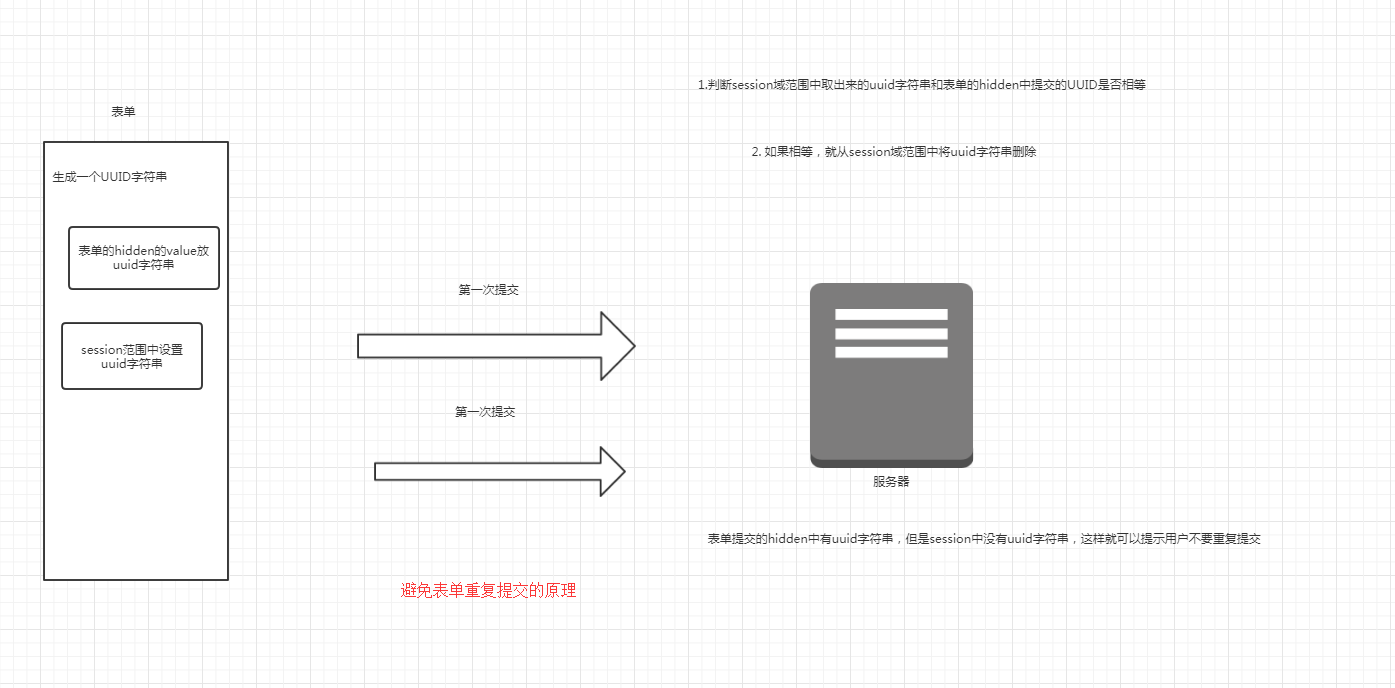Struts2 (三)
1 Struts2的拦截器

- Struts2拦截器在访问某个Action方法之前或之后实施拦截,拦截器是可插拔的,拦截器是AOP的一种实现。
- Struts2拦截器栈:将拦截器按一定顺序联结成一条链,在访问被拦截的方式的时候,Struts2拦截器链中的拦截器就会按之前定义的顺序被依次调用。。
1.1 Interceptor接口
- 每个拦截器都是实现了com.opensyymphony.xwork2.interceptor接口的java类。
//
// Source code recreated from a .class file by IntelliJ IDEA
// (powered by Fernflower decompiler)
//
package com.opensymphony.xwork2.interceptor;
import com.opensymphony.xwork2.ActionInvocation;
import java.io.Serializable;
public interface Interceptor extends Serializable {
void destroy();
void init();
String intercept(ActionInvocation var1) throws Exception;
}
- init()方法
- 该方法将在拦截器被创建后立即被调用,它在拦截器的生命周期内只被调用一次,可以在该方法中对相关资源进行必要的初始化。
- intercept()方法
- 每拦截一个动作请求,该方法就会被调用一次。
- destory()方法
- 该方法将在拦截器被销毁之前被带哦用,它在拦截器的生命周期中也只被调用一次。
- Struts2会依次调用程序员为某个Action而注册的每个拦截器的intercept()方法。
- 每次调用intercept()方法的时候,Struts2会传递一个ActionInvocation接口的实例。
- ActionInvocation:代表一个给定动作的执行状态,拦截器可以从该类的对象里获取与该动作相关联的Action对象和Result对象,在完成拦截器自己的任务之后,拦截器将调用ActionInvocation对象的invoke()放阿飞前进到Action处理流程的下一个环节。
- AbstractInterceptor类实现了Interceptor解耦,并未init、destory提供了一个空白的实现。
1.2 自定义拦截器
- ①编写一个实现Interceptor接口,或继承AbstractInterceptor类。
- ②在struts.xml中注册自定义拦截器。
- 示例:
- web.xml
<?xml version="1.0" encoding="UTF-8"?>
<web-app xmlns="http://xmlns.jcp.org/xml/ns/javaee"
xmlns:xsi="http://www.w3.org/2001/XMLSchema-instance"
xsi:schemaLocation="http://xmlns.jcp.org/xml/ns/javaee http://xmlns.jcp.org/xml/ns/javaee/web-app_3_1.xsd"
version="3.1">
<filter>
<filter-name>struts2</filter-name>
<filter-class>org.apache.struts2.dispatcher.ng.filter.StrutsPrepareAndExecuteFilter</filter-class>
</filter>
<filter-mapping>
<filter-name>struts2</filter-name>
<url-pattern>/*</url-pattern>
</filter-mapping>
</web-app>
- index.jsp
<%@ page contentType="text/html;charset=UTF-8" language="java" %>
<html>
<head>
<title>首页</title>
</head>
<body>
<a href="${pageContext.request.contextPath}/update">更新</a>
<a href="${pageContext.request.contextPath}/save">保存</a>
</body>
</html>
- User.java
package com.xuweiwei.domain;
import java.io.Serializable;
public class User implements Serializable {
private String username;
private String password;
public String getUsername() {
return username;
}
public void setUsername(String username) {
this.username = username;
}
public String getPassword() {
return password;
}
public void setPassword(String password) {
this.password = password;
}
}
- CustomerAction.java
package com.xuweiwei.action;
import com.opensymphony.xwork2.Action;
import com.opensymphony.xwork2.ActionSupport;
import com.xuweiwei.domain.User;
import org.apache.struts2.ServletActionContext;
import javax.servlet.http.HttpSession;
public class CustomerAction extends ActionSupport {
//保存方法
public String save(){
System.out.println("保存");
return Action.SUCCESS;
}
//更新方法
public String update(){
System.out.println("更新");
return Action.SUCCESS;
}
//登录方法
public String login(){
HttpSession sessoin = ServletActionContext.getRequest().getSession();
sessoin.setAttribute("user",new User());
return Action.SUCCESS;
}
}
- LoginInterceptor.java
package com.xuweiwei.interceptor;
import com.opensymphony.xwork2.Action;
import com.opensymphony.xwork2.ActionInvocation;
import com.opensymphony.xwork2.interceptor.MethodFilterInterceptor;
import com.xuweiwei.domain.User;
import org.apache.struts2.ServletActionContext;
import javax.servlet.http.HttpSession;
public class LoginInterceptor extends MethodFilterInterceptor {
@Override
protected String doIntercept(ActionInvocation invocation) throws Exception {
HttpSession session = ServletActionContext.getRequest().getSession();
User user = (User) session.getAttribute("user");
if(user != null){
return invocation.invoke();
}else{
return Action.LOGIN;
}
}
}
- struts.xml
<?xml version="1.0"?>
<!DOCTYPE struts PUBLIC
"-//Apache Software Foundation//DTD Struts Configuration 2.3//EN"
"http://struts.apache.org/dtds/struts-2.3.dtd">
<struts>
<package name="default" namespace="/" extends="struts-default">
<interceptors>
<interceptor name="LoginInterceptor" class="com.xuweiwei.interceptor.LoginInterceptor">
<param name="excludeMethods">login</param>
</interceptor>
<interceptor-stack name="myDefaultStack">
<interceptor-ref name="LoginInterceptor"/>
<interceptor-ref name="defaultStack"/>
</interceptor-stack>
</interceptors>
<default-interceptor-ref name="myDefaultStack"/>
<global-results>
<result name="login" type="redirect">/login.jsp</result>
</global-results>
<action name="save" class="com.xuweiwei.action.CustomerAction" method="save">
<result name="success">/success.jsp</result>
</action>
<action name="update" class="com.xuweiwei.action.CustomerAction" method="update">
<result name="success">/success.jsp</result>
</action>
<action name="login" class="com.xuweiwei.action.CustomerAction" method="login">
<result name="success">/index.jsp</result>
</action>
</package>
</struts>
- success.jsp
<%@ page contentType="text/html;charset=UTF-8" language="java" %>
<html>
<head>
<title>成功</title>
</head>
<body>
成功
</body>
</html>
- login.jsp
<%@ page contentType="text/html;charset=UTF-8" language="java" %>
<html>
<head>
<title>登录</title>
</head>
<body>
<a href="${pageContext.request.contextPath}/login">登录</a>
</body>
</html>
- 执行过程:
- ①当用户访问index.jsp中的超链接,不管是保存还是更新,都需要经过LoginInterceptor拦截器。
- ②LoginInterceptor拦截器会从session中访问是否有登录的标记,如果没有,那么就跳转到login视图。
- ③我们查看struts.xml文件可以知道login视图是一个全局视图,然后重定向或转发到login,jsp(我这里使用的是重定向)。
- ④当用户点击登录按钮的时候,这次我们查看struts.xml可以LoginInterceptor拦截器将login方法放行了,这个时候,执行login()方法,一旦login()方法执行了,就向session中放入登录的标记,然后转到index.jsp。
- ⑤当用户再次点击保存或更新的时候,会再次经过LoginInterceptor,这个时候,LoginInterceptor会判断session中有登录标记,那么就放行,然后去执行save或update方法,执行完毕之后,跳转到success.jsp。
2 表单重复提交

- 还有一种解决方案就是:当用户提交成功之后,就进行页面的重定向,这样路径就不一样了,即使用户不停的刷新f5,也是不一样的。
3 OGNL
3.1 OGNL的概述
- OGNL:对象图导航语言的缩写,是一个开源项目。
3.2 OGNL相对其它表达式语言具有下面的优势
- 前提:在Struts2中用OGNL,需要用到标签。
- 支持对象方法的调用。
<%@ page contentType="text/html;charset=UTF-8" language="java" %>
<%@ taglib prefix="s" uri="/struts-tags" %>
<html>
<head>
<title>首页</title>
</head>
<body>
<s:property value="'abcdefg'.endsWith('a')"></s:property>
</body>
</html>
- 支持类的静态属性的调用
<%@ page contentType="text/html;charset=UTF-8" language="java" %>
<%@ taglib prefix="s" uri="/struts-tags" %>
<html>
<head>
<title>首页</title>
</head>
<body>
<s:property value="@java.lang.Integer@MAX_VALUE"></s:property>
</body>
</html>
- 支持类的静态方法的调用(在Struts2中默认是关闭的,所以需要开启)
- Struts.xml
<?xml version="1.0"?>
<!DOCTYPE struts PUBLIC
"-//Apache Software Foundation//DTD Struts Configuration 2.3//EN"
"http://struts.apache.org/dtds/struts-2.3.dtd">
<struts>
<constant name="struts.ognl.allowStaticMethodAccess" value="true"></constant>
</struts>
- index.jsp
<%@ page contentType="text/html;charset=UTF-8" language="java" %>
<%@ taglib prefix="s" uri="/struts-tags" %>
<html>
<head>
<title>首页</title>
</head>
<body>
<s:property value="@java.util.UUID@randomUUID()"></s:property>
</body>
</html>
- 支持赋值操作和表达式的串联
- 访问OGNL上下文和ActionContext
- 操作集合对象
4 ValueStack
4.1 ValueStack的生命周期
- 每次Action的访问都会创建一个ValueStack,动作类的实例生命周期也是每次访问的时候创建的。
4.2 ValueStack和ActionContext的关系(源码解析)
- ActionContext.java
//
// Source code recreated from a .class file by IntelliJ IDEA
// (powered by Fernflower decompiler)
//
package com.opensymphony.xwork2;
import com.opensymphony.xwork2.inject.Container;
import com.opensymphony.xwork2.util.ValueStack;
import java.io.Serializable;
import java.util.HashMap;
import java.util.Locale;
import java.util.Map;
public class ActionContext implements Serializable {
static ThreadLocal<ActionContext> actionContext = new ThreadLocal();
public static final String ACTION_NAME = "com.opensymphony.xwork2.ActionContext.name";
public static final String VALUE_STACK = "com.opensymphony.xwork2.util.ValueStack.ValueStack";
public static final String SESSION = "com.opensymphony.xwork2.ActionContext.session";
public static final String APPLICATION = "com.opensymphony.xwork2.ActionContext.application";
public static final String PARAMETERS = "com.opensymphony.xwork2.ActionContext.parameters";
public static final String LOCALE = "com.opensymphony.xwork2.ActionContext.locale";
public static final String TYPE_CONVERTER = "com.opensymphony.xwork2.ActionContext.typeConverter";
public static final String ACTION_INVOCATION = "com.opensymphony.xwork2.ActionContext.actionInvocation";
public static final String CONVERSION_ERRORS = "com.opensymphony.xwork2.ActionContext.conversionErrors";
public static final String CONTAINER = "com.opensymphony.xwork2.ActionContext.container";
private Map<String, Object> context;
public ActionContext(Map<String, Object> context) {
this.context = context;
}
public void setActionInvocation(ActionInvocation actionInvocation) {
this.put("com.opensymphony.xwork2.ActionContext.actionInvocation", actionInvocation);
}
public ActionInvocation getActionInvocation() {
return (ActionInvocation)this.get("com.opensymphony.xwork2.ActionContext.actionInvocation");
}
public void setApplication(Map<String, Object> application) {
this.put("com.opensymphony.xwork2.ActionContext.application", application);
}
public Map<String, Object> getApplication() {
return (Map)this.get("com.opensymphony.xwork2.ActionContext.application");
}
public static void setContext(ActionContext context) {
actionContext.set(context);
}
public static ActionContext getContext() {
return (ActionContext)actionContext.get();
}
public void setContextMap(Map<String, Object> contextMap) {
getContext().context = contextMap;
}
public Map<String, Object> getContextMap() {
return this.context;
}
public void setConversionErrors(Map<String, Object> conversionErrors) {
this.put("com.opensymphony.xwork2.ActionContext.conversionErrors", conversionErrors);
}
public Map<String, Object> getConversionErrors() {
Map<String, Object> errors = (Map)this.get("com.opensymphony.xwork2.ActionContext.conversionErrors");
if (errors == null) {
errors = new HashMap();
this.setConversionErrors((Map)errors);
}
return (Map)errors;
}
public void setLocale(Locale locale) {
this.put("com.opensymphony.xwork2.ActionContext.locale", locale);
}
public Locale getLocale() {
Locale locale = (Locale)this.get("com.opensymphony.xwork2.ActionContext.locale");
if (locale == null) {
locale = Locale.getDefault();
this.setLocale(locale);
}
return locale;
}
public void setName(String name) {
this.put("com.opensymphony.xwork2.ActionContext.name", name);
}
public String getName() {
return (String)this.get("com.opensymphony.xwork2.ActionContext.name");
}
public void setParameters(Map<String, Object> parameters) {
this.put("com.opensymphony.xwork2.ActionContext.parameters", parameters);
}
public Map<String, Object> getParameters() {
return (Map)this.get("com.opensymphony.xwork2.ActionContext.parameters");
}
public void setSession(Map<String, Object> session) {
this.put("com.opensymphony.xwork2.ActionContext.session", session);
}
public Map<String, Object> getSession() {
return (Map)this.get("com.opensymphony.xwork2.ActionContext.session");
}
public void setValueStack(ValueStack stack) {
this.put("com.opensymphony.xwork2.util.ValueStack.ValueStack", stack);
}
public ValueStack getValueStack() {
return (ValueStack)this.get("com.opensymphony.xwork2.util.ValueStack.ValueStack");
}
public void setContainer(Container cont) {
this.put("com.opensymphony.xwork2.ActionContext.container", cont);
}
public Container getContainer() {
return (Container)this.get("com.opensymphony.xwork2.ActionContext.container");
}
public <T> T getInstance(Class<T> type) {
Container cont = this.getContainer();
if (cont != null) {
return cont.getInstance(type);
} else {
throw new XWorkException("Cannot find an initialized container for this request.");
}
}
public Object get(String key) {
return this.context.get(key);
}
public void put(String key, Object value) {
this.context.put(key, value);
}
}
- ValueStack.java
//
// Source code recreated from a .class file by IntelliJ IDEA
// (powered by Fernflower decompiler)
//
package com.opensymphony.xwork2.util;
import java.util.Map;
public interface ValueStack {
String VALUE_STACK = "com.opensymphony.xwork2.util.ValueStack.ValueStack";
String REPORT_ERRORS_ON_NO_PROP = "com.opensymphony.xwork2.util.ValueStack.ReportErrorsOnNoProp";
Map<String, Object> getContext();
void setDefaultType(Class var1);
void setExprOverrides(Map<Object, Object> var1);
Map<Object, Object> getExprOverrides();
CompoundRoot getRoot();
void setValue(String var1, Object var2);
void setParameter(String var1, Object var2);
void setValue(String var1, Object var2, boolean var3);
String findString(String var1);
String findString(String var1, boolean var2);
Object findValue(String var1);
Object findValue(String var1, boolean var2);
Object findValue(String var1, Class var2);
Object findValue(String var1, Class var2, boolean var3);
Object peek();
Object pop();
void push(Object var1);
void set(String var1, Object var2);
int size();
}
- CompoundRoot.java
//
// Source code recreated from a .class file by IntelliJ IDEA
// (powered by Fernflower decompiler)
//
package com.opensymphony.xwork2.util;
import java.util.ArrayList;
import java.util.List;
public class CompoundRoot extends ArrayList {
public CompoundRoot() {
}
public CompoundRoot(List list) {
super(list);
}
public CompoundRoot cutStack(int index) {
return new CompoundRoot(this.subList(index, this.size()));
}
public Object peek() {
return this.get(0);
}
public Object pop() {
return this.remove(0);
}
public void push(Object o) {
this.add(0, o);
}
}
- ①我们查看CompoundRoo可以看出这个类继承了ArrayList,但是它同时也是一个栈结构。
- ②解析ActionContext
static ThreadLocal<ActionContext> actionContext = new ThreadLocal();
- 从上面的代码中,我们可以看出ActionContext是和线程绑定在一起的,也就是说,同一个线程,是可以共享ActionContext的。
public static final String ACTION_NAME = "com.opensymphony.xwork2.ActionContext.name"; public static final String VALUE_STACK = "com.opensymphony.xwork2.util.ValueStack.ValueStack"; public static final String SESSION = "com.opensymphony.xwork2.ActionContext.session"; public static final String APPLICATION = "com.opensymphony.xwork2.ActionContext.application"; public static final String PARAMETERS = "com.opensymphony.xwork2.ActionContext.parameters"; public static final String LOCALE = "com.opensymphony.xwork2.ActionContext.locale"; public static final String TYPE_CONVERTER = "com.opensymphony.xwork2.ActionContext.typeConverter"; public static final String ACTION_INVOCATION = "com.opensymphony.xwork2.ActionContext.actionInvocation"; public static final String CONVERSION_ERRORS = "com.opensymphony.xwork2.ActionContext.conversionErrors"; public static final String CONTAINER = "com.opensymphony.xwork2.ActionContext.container";
- 从上面的代码中,我们可以看出这里的ActionContext中的常量,其中需要注意的VALUE_STACK这个常量。因为ValueStack接口的全类名就是这个常量的值。
private Map<String, Object> context;
- 从上面的代码中,我们可以看出ActionContext中维护了一个名为context的Map接口。
public ActionContext(Map<String, Object> context) {
this.context = context;
}
- 从上面的代码中,我们可以看出通过构造方法来给context这个属性赋值。
public void put(String key, Object value) {
this.context.put(key, value);
}
- 从上面的代码中,我们可以看出这个方法就是向名为context的Map中添加值。
public void setActionInvocation(ActionInvocation actionInvocation) {
this.put("com.opensymphony.xwork2.ActionContext.actionInvocation", actionInvocation);
}
- 从上面的代码中,我们可以看出这个方法就是向名为context的Map设置key为com.opensymphony.xworks.ActionContext.actionInvocation,value为ActionInvocation的实例对象。
public ActionInvocation getActionInvocation() {
return (ActionInvocation)this.get("com.opensymphony.xwork2.ActionContext.actionInvocation");
}
- 从上面的代码中,我们可以看出这个方法就是从context的Map中获取key为com.opensymphony.xworks.ActionContext.actionInvocation的value,即ActionContext的实例对象。
this.put("com.opensymphony.xwork2.ActionContext.application", application);
}
public Map<String, Object> getApplication() {
return (Map)this.get("com.opensymphony.xwork2.ActionContext.application");
}
public void setConversionErrors(Map<String, Object> conversionErrors) {
this.put("com.opensymphony.xwork2.ActionContext.conversionErrors", conversionErrors);
}
public Map<String, Object> getConversionErrors() {
Map<String, Object> errors = (Map)this.get("com.opensymphony.xwork2.ActionContext.conversionErrors");
if (errors == null) {
errors = new HashMap();
this.setConversionErrors((Map)errors);
}
return (Map)errors;
}
public void setLocale(Locale locale) {
this.put("com.opensymphony.xwork2.ActionContext.locale", locale);
}
public Locale getLocale() {
Locale locale = (Locale)this.get("com.opensymphony.xwork2.ActionContext.locale");
if (locale == null) {
locale = Locale.getDefault();
this.setLocale(locale);
}
return locale;
}
public void setName(String name) {
this.put("com.opensymphony.xwork2.ActionContext.name", name);
}
public String getName() {
return (String)this.get("com.opensymphony.xwork2.ActionContext.name");
}
public void setParameters(Map<String, Object> parameters) {
this.put("com.opensymphony.xwork2.ActionContext.parameters", parameters);
}
public Map<String, Object> getParameters() {
return (Map)this.get("com.opensymphony.xwork2.ActionContext.parameters");
}
public void setSession(Map<String, Object> session) {
this.put("com.opensymphony.xwork2.ActionContext.session", session);
}
public Map<String, Object> getSession() {
return (Map)this.get("com.opensymphony.xwork2.ActionContext.session");
}
public void setValueStack(ValueStack stack) {
this.put("com.opensymphony.xwork2.util.ValueStack.ValueStack", stack);
}
public ValueStack getValueStack() {
return (ValueStack)this.get("com.opensymphony.xwork2.util.ValueStack.ValueStack");
}
public void setContainer(Container cont) {
this.put("com.opensymphony.xwork2.ActionContext.container", cont);
}
public Container getContainer() {
return (Container)this.get("com.opensymphony.xwork2.ActionContext.container");
}
public <T> T getInstance(Class<T> type) {
Container cont = this.getContainer();
if (cont != null) {
return cont.getInstance(type);
} else {
throw new XWorkException("Cannot find an initialized container for this request.");
}
}
- 这些代码的功能,和上述的相同,就是向名为context的Map中存值和取值。
public Object get(String key) {
return this.context.get(key);
}
- 从上面的代码中,我们可以看出这个方法,是可以从Map中获取指定的key的value。
public static void setContext(ActionContext context) {
actionContext.set(context);
}
public static ActionContext getContext() {
return (ActionContext)actionContext.get();
}
- 从上面的代码中,我们可以看出就是将context这个属性对象设置到ThreadLocal中。
public void setContextMap(Map<String, Object> contextMap) {
getContext().context = contextMap;
}
public Map<String, Object> getContextMap() {
return this.context;
}
- 从上面的代码中,我们可以看出其就是将传递过来的Map对象,直接设置到ThreadLocal中。
- ③解析ValueStack接口
Map<String, Object> getContext();
- 从上面的代码中,我们可以看出这个方法的功能就是获取ActionContext对象内部的那个名为context的Map集合。
- 图解:ActionContext和ValueStack的关系

4.3 获取ValueStack的三种方式
- 方式一:
ValueStack valueStack = ActionContext.getContext().getValueStack();
- 方式二:
ValueStack valueStack = (ValueStack) ActionContext.getContext().get(ValueStack.VALUE_STACK);
- 方式三:
ValueStack valueStack = (ValueStack) ServletActionContext.getRequest().getAttribute("struts.valueStack");
4.4 ValueStack常用的方法
- 先获取根栈栈顶的Map,如果不存在,压入一个新的Map,把key和value方法这个新创建的Map中,如果Map已经存在,那么就是存放key和value。
void set(String var1, Object var2);
- String是一个OGNL表达式,如果表达式是以#开头,操作的是contextMap,如果不是,设置根栈中对象的某个属性,从栈顶依次查找
void setValue(String ognlExp, Object var2);
- String是一个OGNL表达式,如果以#开头,从contextMap中找key值对应的对象,如果不是,搜索根栈中对象的属性。【注意】如果编写的表达式不是以#开头,先搜索根栈对象的所有属性,如果没有找到,会把它当做key设置到contextMap中。
Object findValue(String var1);
- 和findValue的功能一样,但是把OGNL表达式虎丘的对象转换为String。
String findString(String var1);
Struts2 (三)的更多相关文章
- Struts2(三)——数据在框架中的数据流转问题
一款软件,无在乎对数据的处理.而B/S软件,一般都是用户通过浏览器客户端输入数据,传递到服务器,服务器进行相关处理,然后返回到指定的页面,进行相关显示,完成相关功能.这篇博客重点简述一下Struts2 ...
- 框架学习之Struts2(三)---OGNL和值栈
一.OGNL概述 1.1OGNL是对象图导航语言(Object-Graph Navigation Languaged)的缩写,他是一种功能强大的表达式语言,通过简单一致的表达式语法,可以存取Java对 ...
- struts2(三) 输入校验和拦截器
前面知道了struts2的架构图和struts2的自动封装表单参数和数据类型自动转换,今天来学struts2的第三第四个东西,输入校验和拦截器, --WH 一.输入校验 在以前我们写一个登录页面时,并 ...
- Struts2(三)配置详解
一.概述 Struts2提供了多种可选的配置文件形式. 其中,struts-default.xml和default.properties是框架级别的配置文件,这两个文件在Struts的核心JAR包中, ...
- Struts2 (三) — OGNL与值栈
一.OGNL表达式 1.概述 1.1什么是OGNL OGNL是Object-Graph Navigation Language的缩写,俗称对象图导航语言. 它是一种功能强大的表达式语言,通过它简单 ...
- Struts2(三):新建Struts2工程
下载的struts2xx-all.zip包对搭建项目的作用 一般情况下,我们下载一个Struts2的full包时,并不知道新建过程中需要哪些包,那么这时我们可以从下载的包中解压出的目录\apps\st ...
- Struts2 三、指定Struts2处理的请求后缀
Action的请求通常情况下默认为以.action结尾,例如:http://localhost:9000/Struts2/hello/helloAction_sayHello.action .a ...
- 浅谈Struts2(三)
一.Struts2收集client的参数 核心思路: <form method="post" action="XXXX"> <input ty ...
- 深入struts2(三)---工作机制和运行流程图
1 工作原理 1.1 体系架构 图2.1 struts2.0体系架构图 1.2 工作机制 针对上节体系架构图,以下分步说明运行流程 Ø client初始化一个指向Servle ...
随机推荐
- 解决linux 乌班图下使用eclipse创建类和其他各种操作进程卡死的问题的一种可能方法
[转载]http://blog.csdn.net/u010652906/article/details/51626257Eclipse设置面板菜单可以点,左边面板不出现,创建类.创建包都会卡死的问题, ...
- 知乎上看到的关于类.class,对象.getClass
public class TestDemo { //测试 @Test public void fun01() { TestDemo q=new TestDemo(); A a = new A(); q ...
- uImage和zImage的区别
1.各种文件的意义 vmlinux 编译出来的最原始的内核文件,未压缩. zImage 是vmlinux经过gzip压缩后的文件. bzImage bz表示“big zImage”,不是用bzi ...
- 使用神经网络来拟合函数y = x^3 +b
我们使用一个三层的小网络来,模拟函数y = x^3+b函数 import tensorflow as tf import numpy as np import matplotlib.pyplot as ...
- AFO
留坑 有点绝望 状态什么的,存在么 upd at 2017/11/14还算完满地结束了OI之路了吧.
- 2017ICPC/广西邀请赛1001(水)HDU6181
A Math Problem Time Limit: 2000/1000 MS (Java/Others) Memory Limit: 32768/32768 K (Java/Others)To ...
- 通过案例理解position:relative和position:absolute
w3school过了HTML的知识之后,觉得要自己单纯地去啃知识点有点枯燥,然后自己也很容易忘记,所以便找具体的网站练手便补上不懂的知识点.position:relative和postion:abso ...
- 用 Deployment 运行应用 - 每天5分钟玩转 Docker 容器技术(123)
从本章开始,我们将通过实践深入学习 Kubernetes 的各种特性.作为容器编排引擎,最重要也是最基本的功能当然是运行容器化应用,这就是本章的内容. Deployment 前面我们已经了解到,Kub ...
- Docker+Jenkins持续集成环境(3)集成PMD、FindBugs、Checkstyle静态代码检查工具并邮件发送检查结果
为了规范代码,我们一般会集成静态代码检测工具,比如PMD.FindBugs.Checkstyle,那么Jenkins如何集成这些检查工具,并把检查结果放到构建邮件里呢? 今天做了调研和实现,过程如下 ...
- 【shell mysql 导出数据到csv脚本,完美解决乱码转义符等问题】-费元星
#!/bin/bash#@author:feiyuanxing [既然笨到家,就要努力到家]#@date:2017-12-05#@E-Mail:feiyuanxing@gmail.com#@TARGE ...
